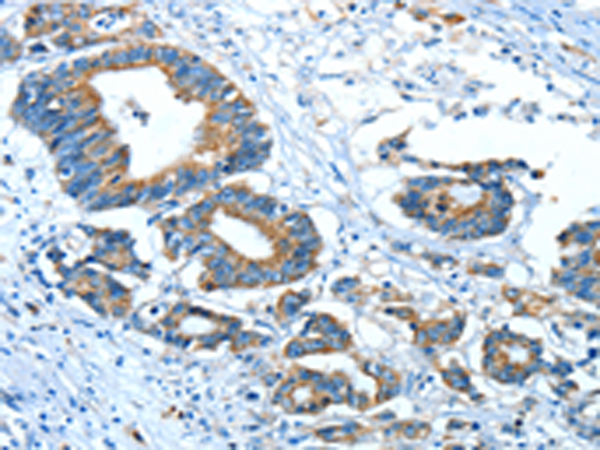

| WB | 咨询技术 | Human,Mouse,Rat |
| IF | 咨询技术 | Human,Mouse,Rat |
| IHC | 1/25-1/100 | Human,Mouse,Rat |
| ICC | 技术咨询 | Human,Mouse,Rat |
| FCM | 咨询技术 | Human,Mouse,Rat |
| Elisa | 1/2000-1/5000 | Human,Mouse,Rat |
| Aliases | STHE; HKPX1 |
| WB Predicted band size | 53 kDa |
| Host/Isotype | Rabbit IgG |
| Antibody Type | Primary antibody |
| Storage | Store at 4°C short term. Aliquot and store at -20°C long term. Avoid freeze/thaw cycles. |
| Species Reactivity | Human, Mouse, Rat |
| Immunogen | Synthetic peptide of human GLRA1 |
| Formulation | Purified antibody in PBS with 0.05% sodium azide and 50% glycerol. |
+ +
以下是关于GLRA1抗体的3篇参考文献示例(基于公开知识库信息整理,建议通过学术数据库进一步验证):
---
1. **文献名称**:*Glycine receptor antibodies in PERM and related syndromes: characteristics, clinical relevance and outcomes*
**作者**:Carvajal-González, A. et al.
**摘要**:该研究探讨了甘氨酸受体α1(GLRA1)抗体与进行性脑炎伴强直和肌阵挛(PERM)的关联。研究发现,GLRA1抗体阳性患者表现出严重的脑干和脊髓症状,免疫治疗(如类固醇或静脉注射免疫球蛋白)可显著改善症状,提示抗体检测对诊断和指导治疗具有重要意义。
2. **文献名称**:*Antibodies to glycine receptor in stiff-person syndrome and other CNS disorders*
**作者**:Hutchinson, M. et al.
**摘要**:研究分析了GLRA1抗体在僵人综合征(SPS)及其他中枢神经系统疾病中的作用。通过血清学检测发现,部分SPS患者存在GLRA1抗体,且这些抗体可能导致甘氨酸能神经传递障碍,进而引发肌肉强直和痉挛。研究支持GLRA1抗体作为神经自身免疫疾病的生物标志物。
3. **文献名称**:*Clinical spectrum of glycine receptor antibody-associated encephalitis*
**作者**:McKeon, A. et al.
**摘要**:文章总结了GLRA1抗体相关脑炎的临床特征,包括快速进展的肌强直、自主神经功能障碍和过度惊跳反应。病例分析表明,此类患者对免疫疗法反应良好,强调早期抗体检测及针对性治疗的重要性。
---
**备注**:部分文献可能以GlyR(甘氨酸受体)抗体为研究对象,而GLRA1是其关键亚基。实际研究中需结合具体检测靶点确认。建议通过PubMed或Google Scholar以“GLRA1 antibody”“GlyR antibody”“glycine receptor autoimmune”等关键词检索最新文献。
The glycine receptor alpha 1 (GLRA1) antibody is an autoantibody targeting the α1 subunit of glycine receptors, ligand-gated chloride channels critical for inhibitory neurotransmission in the central nervous system. GLRA1 is predominantly expressed in the brainstem, spinal cord, and retina, where it regulates motor coordination, pain perception, and startle reflexes. Autoantibodies against GLRA1 are associated with rare autoimmune neurological disorders, notably progressive encephalomyelitis with rigidity and myoclonus (PERM), a severe variant of stiff-person syndrome (SPS). These antibodies disrupt glycine-mediated inhibitory signaling, leading to hyperexcitability of motor neurons, which manifests as muscle rigidity, spasms, and brainstem dysfunction.
First identified in the 1990s, GLRA1 antibodies are detected via cell-based assays or immunohistochemistry in patient serum or cerebrospinal fluid. Their presence supports an autoimmune etiology in otherwise unexplained neurological syndromes. Over 50% of cases occur with other autoantibodies (e.g., GAD65), complicating clinical correlations. Treatment often involves immunotherapy (steroids, IVIG, plasmapheresis) with variable efficacy. Research continues to clarify epitope specificity, pathogenic mechanisms, and links to paraneoplastic triggers (e.g., thymoma, lymphoma). Understanding GLRA1 antibodies aids in diagnosing atypical movement disorders and refining targeted therapies.
×